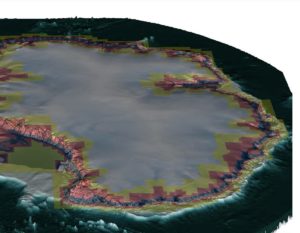 In this video, the DOE SciDAC-funded BISICLES experiment investigates the millennial-scale vulnerability of the Antarctic Ice Sheet (AIS) due solely to the loss of its ice shelves. Starting at the present-day, the AIS evolves for 1000 years, exposing the floating ice shelves to an extreme thinning rate, which results in their complete collapse. The visualizations show the first 500 years of the simulation — after that point, the ice sheet continues to evolve and retreat, but less dramatically.
In this video, the DOE SciDAC-funded BISICLES experiment investigates the millennial-scale vulnerability of the Antarctic Ice Sheet (AIS) due solely to the loss of its ice shelves. Starting at the present-day, the AIS evolves for 1000 years, exposing the floating ice shelves to an extreme thinning rate, which results in their complete collapse. The visualizations show the first 500 years of the simulation — after that point, the ice sheet continues to evolve and retreat, but less dramatically.
DOE’s earth and environmental system modeling has been developing ice sheet models, coupling them into the full earth system, and doing experiments to see how the ice sheets respond under changing environmental conditions. Much of this work has been done in collaboration with the Advanced Scientific Computing Research (ASCR) Office, under the Scientific Discovery through Advanced Computing (SciDAC) program, which supports partnerships between computational experts and earth system modelers. One outcome of this partnership is the BISICLES adaptive mesh refinement (AMR) ice sheet model. AMR places high-resolution gridding in areas where it is needed for accurate solutions, such as where the ice sheets are changing quickly. BISICLES is an important element in the research to understand how the Antarctic Ice Sheet could contribute to sea level rise (SLR). The BISICLES experiment shown here investigates the millennial-scale vulnerability of the Antarctic Ice Sheet (AIS) due solely to the loss of its ice shelves. Starting at the present-day, the AIS evolves for 1000 years, exposing the floating ice shelves to an extreme thinning rate, which results in their complete collapse. The visualizations show the first 500 years of the simulation—after that point, the ice sheet continues to evolve and retreat, but less dramatically.
Source: The Energy Exascale Earth System Model (E3SM) Project




